Sports Psychology: Cross-Sectional and Longitudinal Study Comparison
VerifiedAdded on 2023/01/18
|6
|1517
|89
Homework Assignment
AI Summary
This homework assignment in sports psychology delves into the comparison of two primary research designs: cross-sectional and longitudinal studies. The assignment begins by emphasizing the importance of selecting the appropriate study design based on the research question and the nature of the data required. It provides a detailed overview of both cross-sectional and longitudinal designs, classifying them as observational studies where researchers record data without manipulating the study environment. The assignment then meticulously outlines the advantages and disadvantages of each design. The cross-sectional study, characterized by its ability to compare variables at a single point in time, is praised for its ease and speed. However, its limitations include its inability to analyze conduct over time or determine cause-and-effect relationships. Conversely, the longitudinal study, which involves repeated observations over an extended period, is highlighted for its capacity to reveal developmental changes and potential cause-and-effect relationships. The assignment also acknowledges the drawbacks of longitudinal studies, such as the increased risk of random results over time, the reliance on researcher skill, and potential data consistency issues. The conclusion stresses the importance of research designs and how the development of research can help decide the relevant design.
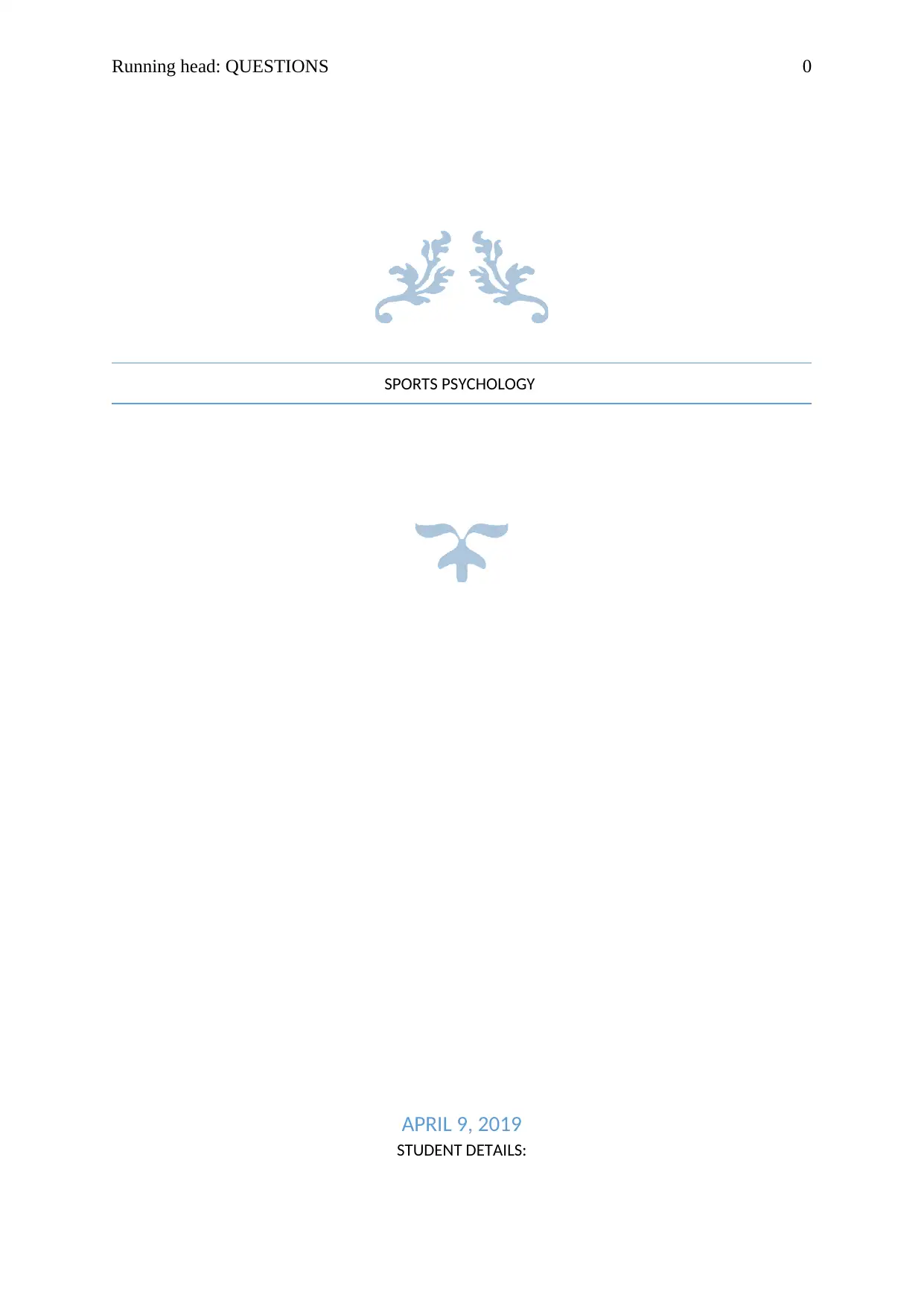
Running head: QUESTIONS 0
SPORTS PSYCHOLOGY
APRIL 9, 2019
STUDENT DETAILS:
SPORTS PSYCHOLOGY
APRIL 9, 2019
STUDENT DETAILS:
Paraphrase This Document
Need a fresh take? Get an instant paraphrase of this document with our AI Paraphraser
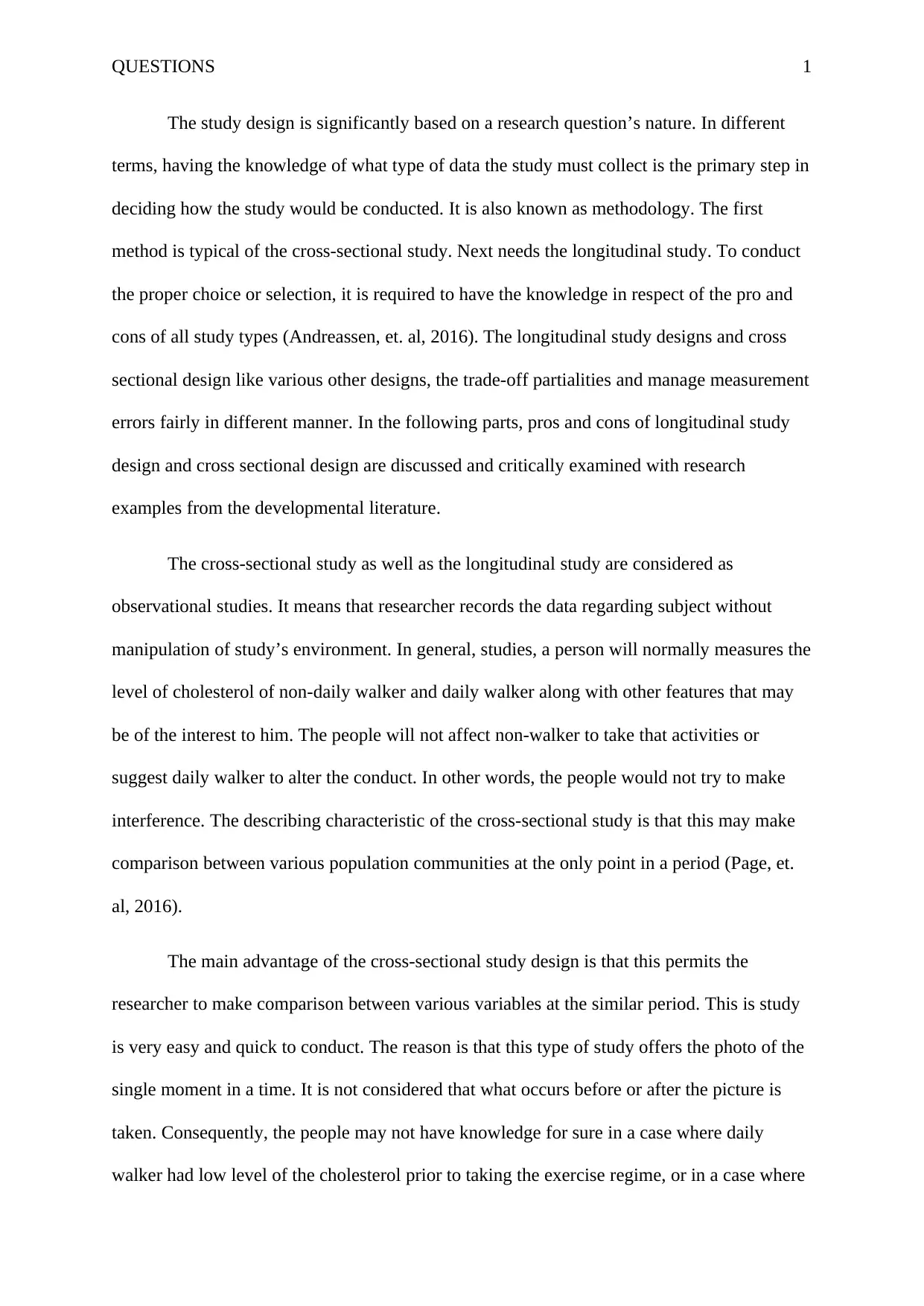
QUESTIONS 1
The study design is significantly based on a research question’s nature. In different
terms, having the knowledge of what type of data the study must collect is the primary step in
deciding how the study would be conducted. It is also known as methodology. The first
method is typical of the cross-sectional study. Next needs the longitudinal study. To conduct
the proper choice or selection, it is required to have the knowledge in respect of the pro and
cons of all study types (Andreassen, et. al, 2016). The longitudinal study designs and cross
sectional design like various other designs, the trade-off partialities and manage measurement
errors fairly in different manner. In the following parts, pros and cons of longitudinal study
design and cross sectional design are discussed and critically examined with research
examples from the developmental literature.
The cross-sectional study as well as the longitudinal study are considered as
observational studies. It means that researcher records the data regarding subject without
manipulation of study’s environment. In general, studies, a person will normally measures the
level of cholesterol of non-daily walker and daily walker along with other features that may
be of the interest to him. The people will not affect non-walker to take that activities or
suggest daily walker to alter the conduct. In other words, the people would not try to make
interference. The describing characteristic of the cross-sectional study is that this may make
comparison between various population communities at the only point in a period (Page, et.
al, 2016).
The main advantage of the cross-sectional study design is that this permits the
researcher to make comparison between various variables at the similar period. This is study
is very easy and quick to conduct. The reason is that this type of study offers the photo of the
single moment in a time. It is not considered that what occurs before or after the picture is
taken. Consequently, the people may not have knowledge for sure in a case where daily
walker had low level of the cholesterol prior to taking the exercise regime, or in a case where
The study design is significantly based on a research question’s nature. In different
terms, having the knowledge of what type of data the study must collect is the primary step in
deciding how the study would be conducted. It is also known as methodology. The first
method is typical of the cross-sectional study. Next needs the longitudinal study. To conduct
the proper choice or selection, it is required to have the knowledge in respect of the pro and
cons of all study types (Andreassen, et. al, 2016). The longitudinal study designs and cross
sectional design like various other designs, the trade-off partialities and manage measurement
errors fairly in different manner. In the following parts, pros and cons of longitudinal study
design and cross sectional design are discussed and critically examined with research
examples from the developmental literature.
The cross-sectional study as well as the longitudinal study are considered as
observational studies. It means that researcher records the data regarding subject without
manipulation of study’s environment. In general, studies, a person will normally measures the
level of cholesterol of non-daily walker and daily walker along with other features that may
be of the interest to him. The people will not affect non-walker to take that activities or
suggest daily walker to alter the conduct. In other words, the people would not try to make
interference. The describing characteristic of the cross-sectional study is that this may make
comparison between various population communities at the only point in a period (Page, et.
al, 2016).
The main advantage of the cross-sectional study design is that this permits the
researcher to make comparison between various variables at the similar period. This is study
is very easy and quick to conduct. The reason is that this type of study offers the photo of the
single moment in a time. It is not considered that what occurs before or after the picture is
taken. Consequently, the people may not have knowledge for sure in a case where daily
walker had low level of the cholesterol prior to taking the exercise regime, or in a case where
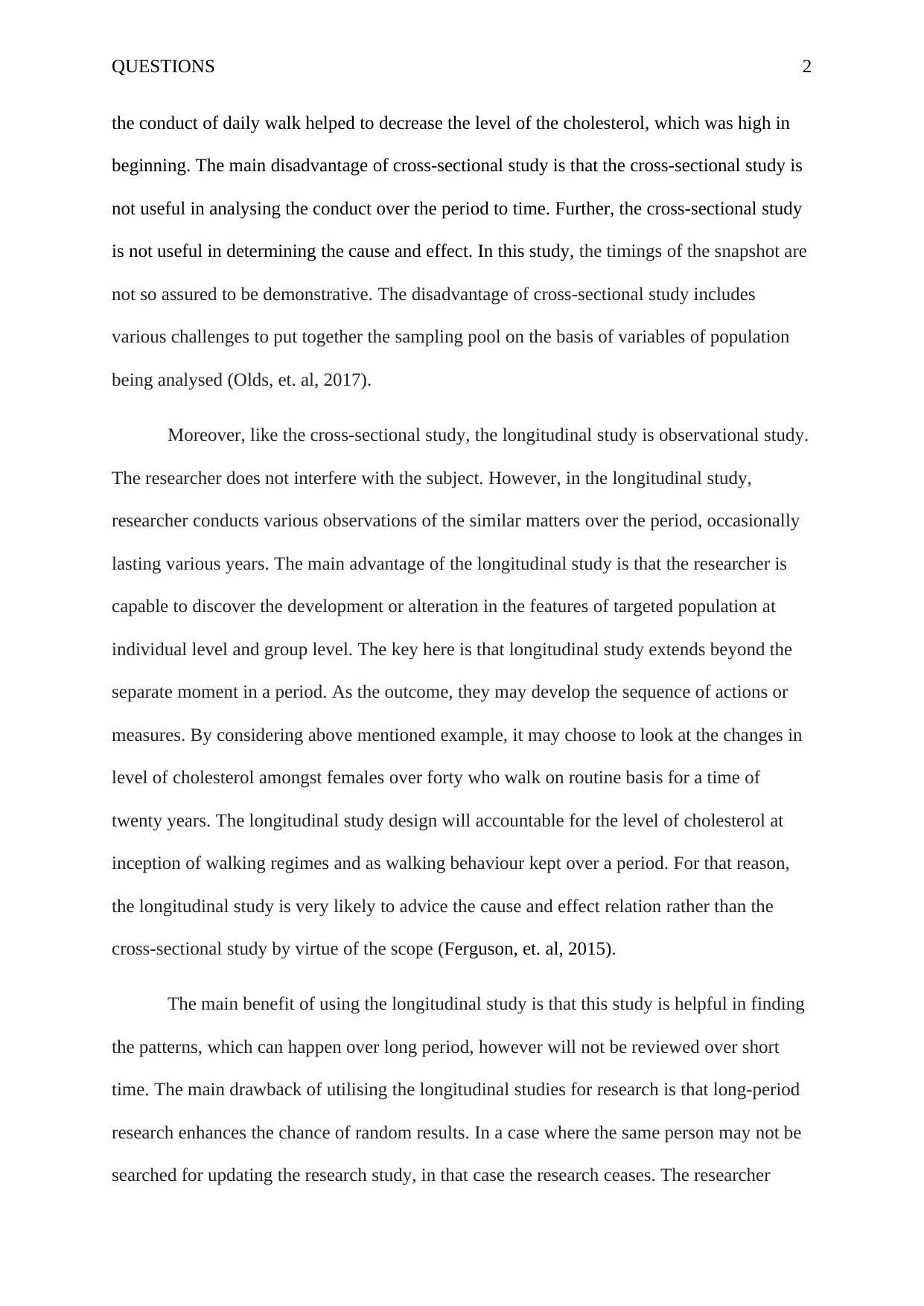
QUESTIONS 2
the conduct of daily walk helped to decrease the level of the cholesterol, which was high in
beginning. The main disadvantage of cross-sectional study is that the cross-sectional study is
not useful in analysing the conduct over the period to time. Further, the cross-sectional study
is not useful in determining the cause and effect. In this study, the timings of the snapshot are
not so assured to be demonstrative. The disadvantage of cross-sectional study includes
various challenges to put together the sampling pool on the basis of variables of population
being analysed (Olds, et. al, 2017).
Moreover, like the cross-sectional study, the longitudinal study is observational study.
The researcher does not interfere with the subject. However, in the longitudinal study,
researcher conducts various observations of the similar matters over the period, occasionally
lasting various years. The main advantage of the longitudinal study is that the researcher is
capable to discover the development or alteration in the features of targeted population at
individual level and group level. The key here is that longitudinal study extends beyond the
separate moment in a period. As the outcome, they may develop the sequence of actions or
measures. By considering above mentioned example, it may choose to look at the changes in
level of cholesterol amongst females over forty who walk on routine basis for a time of
twenty years. The longitudinal study design will accountable for the level of cholesterol at
inception of walking regimes and as walking behaviour kept over a period. For that reason,
the longitudinal study is very likely to advice the cause and effect relation rather than the
cross-sectional study by virtue of the scope (Ferguson, et. al, 2015).
The main benefit of using the longitudinal study is that this study is helpful in finding
the patterns, which can happen over long period, however will not be reviewed over short
time. The main drawback of utilising the longitudinal studies for research is that long-period
research enhances the chance of random results. In a case where the same person may not be
searched for updating the research study, in that case the research ceases. The researcher
the conduct of daily walk helped to decrease the level of the cholesterol, which was high in
beginning. The main disadvantage of cross-sectional study is that the cross-sectional study is
not useful in analysing the conduct over the period to time. Further, the cross-sectional study
is not useful in determining the cause and effect. In this study, the timings of the snapshot are
not so assured to be demonstrative. The disadvantage of cross-sectional study includes
various challenges to put together the sampling pool on the basis of variables of population
being analysed (Olds, et. al, 2017).
Moreover, like the cross-sectional study, the longitudinal study is observational study.
The researcher does not interfere with the subject. However, in the longitudinal study,
researcher conducts various observations of the similar matters over the period, occasionally
lasting various years. The main advantage of the longitudinal study is that the researcher is
capable to discover the development or alteration in the features of targeted population at
individual level and group level. The key here is that longitudinal study extends beyond the
separate moment in a period. As the outcome, they may develop the sequence of actions or
measures. By considering above mentioned example, it may choose to look at the changes in
level of cholesterol amongst females over forty who walk on routine basis for a time of
twenty years. The longitudinal study design will accountable for the level of cholesterol at
inception of walking regimes and as walking behaviour kept over a period. For that reason,
the longitudinal study is very likely to advice the cause and effect relation rather than the
cross-sectional study by virtue of the scope (Ferguson, et. al, 2015).
The main benefit of using the longitudinal study is that this study is helpful in finding
the patterns, which can happen over long period, however will not be reviewed over short
time. The main drawback of utilising the longitudinal studies for research is that long-period
research enhances the chance of random results. In a case where the same person may not be
searched for updating the research study, in that case the research ceases. The researcher
⊘ This is a preview!⊘
Do you want full access?
Subscribe today to unlock all pages.

Trusted by 1+ million students worldwide
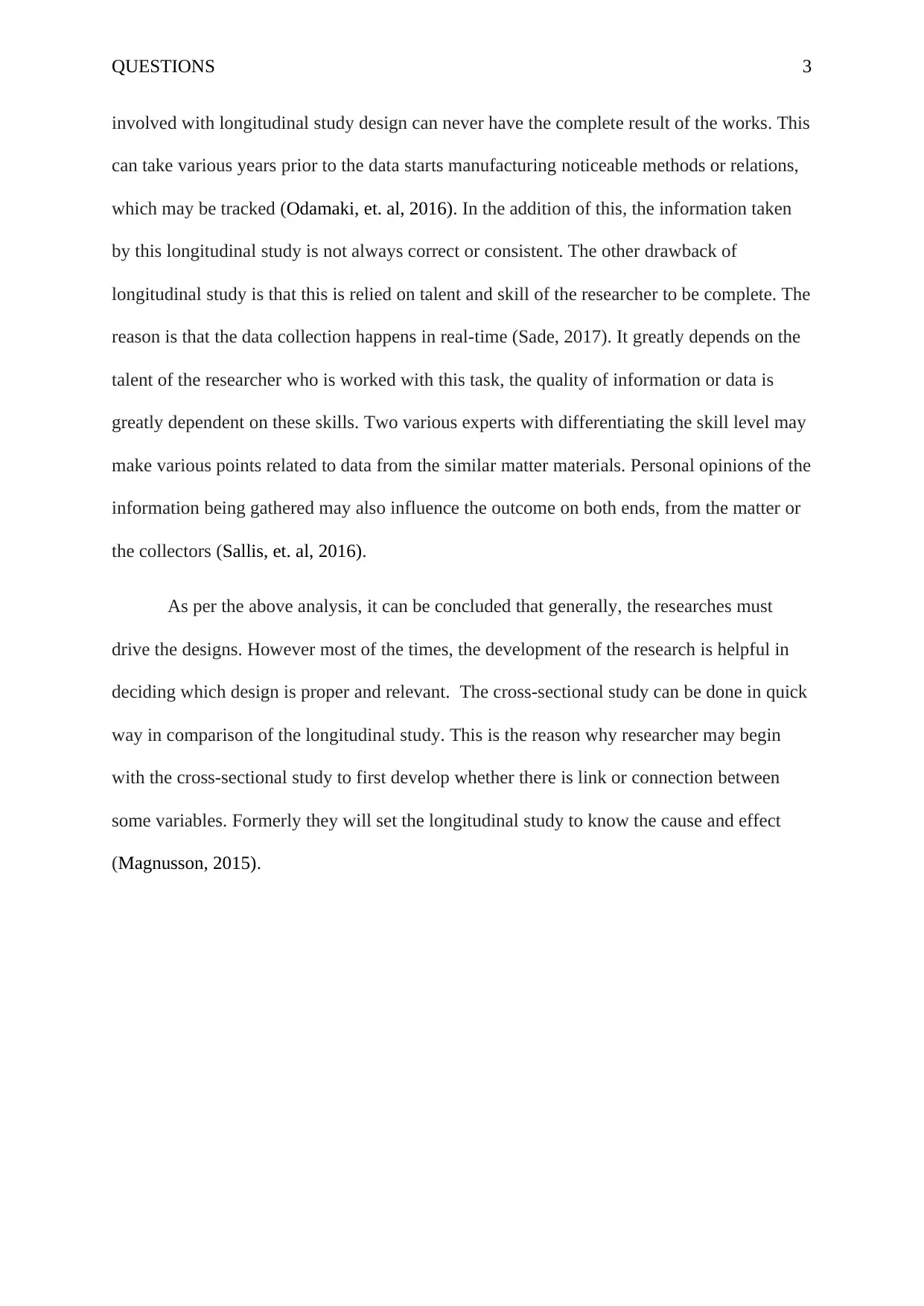
QUESTIONS 3
involved with longitudinal study design can never have the complete result of the works. This
can take various years prior to the data starts manufacturing noticeable methods or relations,
which may be tracked (Odamaki, et. al, 2016). In the addition of this, the information taken
by this longitudinal study is not always correct or consistent. The other drawback of
longitudinal study is that this is relied on talent and skill of the researcher to be complete. The
reason is that the data collection happens in real-time (Sade, 2017). It greatly depends on the
talent of the researcher who is worked with this task, the quality of information or data is
greatly dependent on these skills. Two various experts with differentiating the skill level may
make various points related to data from the similar matter materials. Personal opinions of the
information being gathered may also influence the outcome on both ends, from the matter or
the collectors (Sallis, et. al, 2016).
As per the above analysis, it can be concluded that generally, the researches must
drive the designs. However most of the times, the development of the research is helpful in
deciding which design is proper and relevant. The cross-sectional study can be done in quick
way in comparison of the longitudinal study. This is the reason why researcher may begin
with the cross-sectional study to first develop whether there is link or connection between
some variables. Formerly they will set the longitudinal study to know the cause and effect
(Magnusson, 2015).
involved with longitudinal study design can never have the complete result of the works. This
can take various years prior to the data starts manufacturing noticeable methods or relations,
which may be tracked (Odamaki, et. al, 2016). In the addition of this, the information taken
by this longitudinal study is not always correct or consistent. The other drawback of
longitudinal study is that this is relied on talent and skill of the researcher to be complete. The
reason is that the data collection happens in real-time (Sade, 2017). It greatly depends on the
talent of the researcher who is worked with this task, the quality of information or data is
greatly dependent on these skills. Two various experts with differentiating the skill level may
make various points related to data from the similar matter materials. Personal opinions of the
information being gathered may also influence the outcome on both ends, from the matter or
the collectors (Sallis, et. al, 2016).
As per the above analysis, it can be concluded that generally, the researches must
drive the designs. However most of the times, the development of the research is helpful in
deciding which design is proper and relevant. The cross-sectional study can be done in quick
way in comparison of the longitudinal study. This is the reason why researcher may begin
with the cross-sectional study to first develop whether there is link or connection between
some variables. Formerly they will set the longitudinal study to know the cause and effect
(Magnusson, 2015).
Paraphrase This Document
Need a fresh take? Get an instant paraphrase of this document with our AI Paraphraser
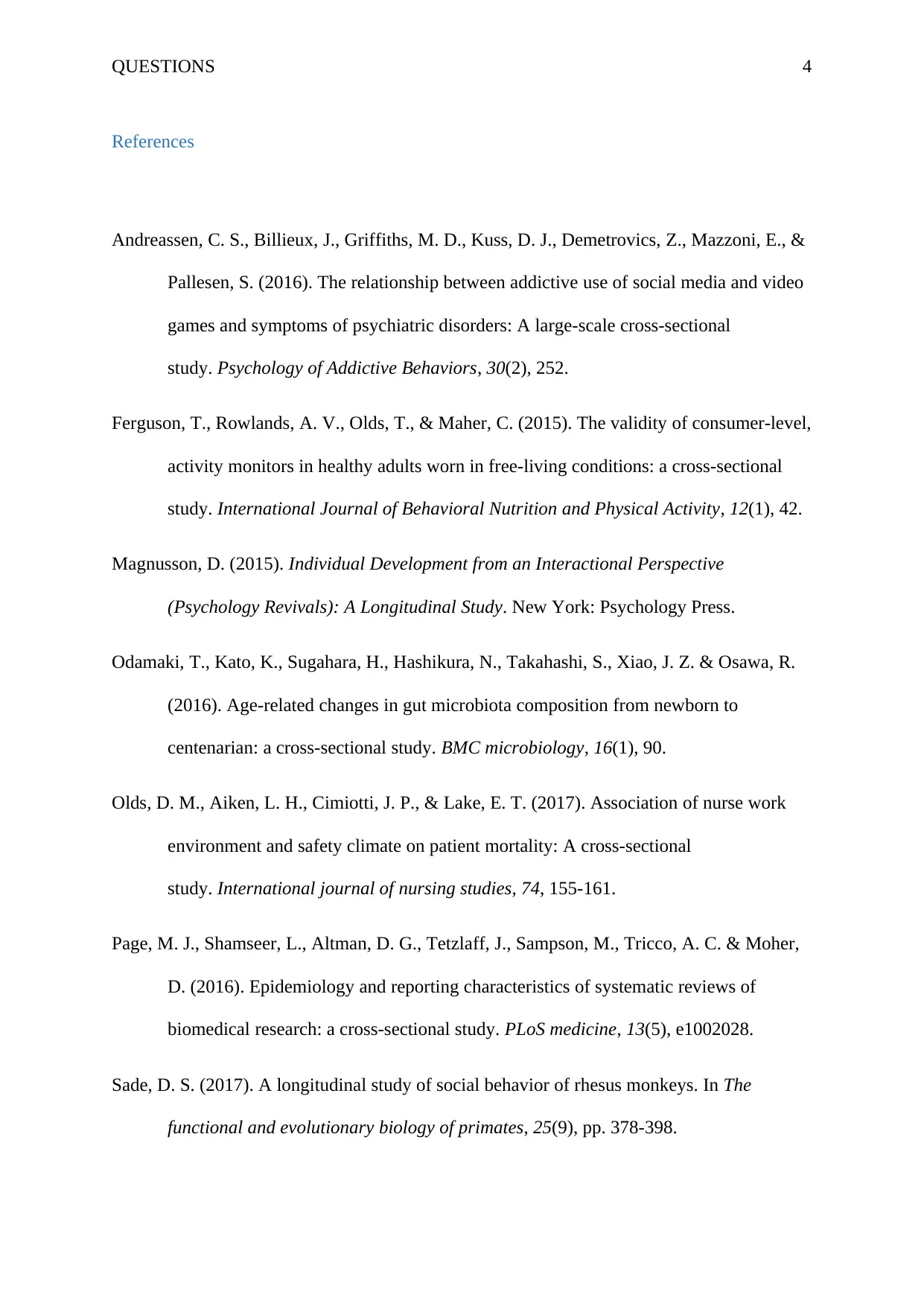
QUESTIONS 4
References
Andreassen, C. S., Billieux, J., Griffiths, M. D., Kuss, D. J., Demetrovics, Z., Mazzoni, E., &
Pallesen, S. (2016). The relationship between addictive use of social media and video
games and symptoms of psychiatric disorders: A large-scale cross-sectional
study. Psychology of Addictive Behaviors, 30(2), 252.
Ferguson, T., Rowlands, A. V., Olds, T., & Maher, C. (2015). The validity of consumer-level,
activity monitors in healthy adults worn in free-living conditions: a cross-sectional
study. International Journal of Behavioral Nutrition and Physical Activity, 12(1), 42.
Magnusson, D. (2015). Individual Development from an Interactional Perspective
(Psychology Revivals): A Longitudinal Study. New York: Psychology Press.
Odamaki, T., Kato, K., Sugahara, H., Hashikura, N., Takahashi, S., Xiao, J. Z. & Osawa, R.
(2016). Age-related changes in gut microbiota composition from newborn to
centenarian: a cross-sectional study. BMC microbiology, 16(1), 90.
Olds, D. M., Aiken, L. H., Cimiotti, J. P., & Lake, E. T. (2017). Association of nurse work
environment and safety climate on patient mortality: A cross-sectional
study. International journal of nursing studies, 74, 155-161.
Page, M. J., Shamseer, L., Altman, D. G., Tetzlaff, J., Sampson, M., Tricco, A. C. & Moher,
D. (2016). Epidemiology and reporting characteristics of systematic reviews of
biomedical research: a cross-sectional study. PLoS medicine, 13(5), e1002028.
Sade, D. S. (2017). A longitudinal study of social behavior of rhesus monkeys. In The
functional and evolutionary biology of primates, 25(9), pp. 378-398.
References
Andreassen, C. S., Billieux, J., Griffiths, M. D., Kuss, D. J., Demetrovics, Z., Mazzoni, E., &
Pallesen, S. (2016). The relationship between addictive use of social media and video
games and symptoms of psychiatric disorders: A large-scale cross-sectional
study. Psychology of Addictive Behaviors, 30(2), 252.
Ferguson, T., Rowlands, A. V., Olds, T., & Maher, C. (2015). The validity of consumer-level,
activity monitors in healthy adults worn in free-living conditions: a cross-sectional
study. International Journal of Behavioral Nutrition and Physical Activity, 12(1), 42.
Magnusson, D. (2015). Individual Development from an Interactional Perspective
(Psychology Revivals): A Longitudinal Study. New York: Psychology Press.
Odamaki, T., Kato, K., Sugahara, H., Hashikura, N., Takahashi, S., Xiao, J. Z. & Osawa, R.
(2016). Age-related changes in gut microbiota composition from newborn to
centenarian: a cross-sectional study. BMC microbiology, 16(1), 90.
Olds, D. M., Aiken, L. H., Cimiotti, J. P., & Lake, E. T. (2017). Association of nurse work
environment and safety climate on patient mortality: A cross-sectional
study. International journal of nursing studies, 74, 155-161.
Page, M. J., Shamseer, L., Altman, D. G., Tetzlaff, J., Sampson, M., Tricco, A. C. & Moher,
D. (2016). Epidemiology and reporting characteristics of systematic reviews of
biomedical research: a cross-sectional study. PLoS medicine, 13(5), e1002028.
Sade, D. S. (2017). A longitudinal study of social behavior of rhesus monkeys. In The
functional and evolutionary biology of primates, 25(9), pp. 378-398.

QUESTIONS 5
Sallis, J. F., Cerin, E., Conway, T. L., Adams, M. A., Frank, L. D., Pratt, M. & Davey, R.
(2016). Physical activity in relation to urban environments in 14 cities worldwide: a
cross-sectional study. The Lancet, 387(10034), 2207-2217.
Sallis, J. F., Cerin, E., Conway, T. L., Adams, M. A., Frank, L. D., Pratt, M. & Davey, R.
(2016). Physical activity in relation to urban environments in 14 cities worldwide: a
cross-sectional study. The Lancet, 387(10034), 2207-2217.
⊘ This is a preview!⊘
Do you want full access?
Subscribe today to unlock all pages.

Trusted by 1+ million students worldwide
1 out of 6
Related Documents
Your All-in-One AI-Powered Toolkit for Academic Success.
+13062052269
info@desklib.com
Available 24*7 on WhatsApp / Email
![[object Object]](/_next/static/media/star-bottom.7253800d.svg)
Unlock your academic potential
Copyright © 2020–2025 A2Z Services. All Rights Reserved. Developed and managed by ZUCOL.

![Business Research Methodology Assignment - [University Name]](/_next/image/?url=https%3A%2F%2Fdesklib.com%2Fmedia%2Fimages%2Ftc%2F83c04ddc07264065ad727bb3f9c2b655.jpg&w=256&q=75)



